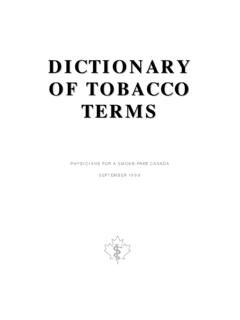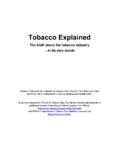Transcription of SmokingCessation Guidelines SC G - Smoke-Free
1 Guidelines S. Smoking Cessation GC. W N. S E. How to Treat your Patient's Tobacco addiction Smoking Cessation Guidelines How to Treat your Patient's Tobacco addiction This publication has been endorsed by the Optimal Therapy Initiative, Department of Family and Community Medicine, University of Toronto Published with the assistance of an education grant from Novartis Consumer Health Canada Inc. A Pegasus Healthcare International Publication, 2000. NEW Guidelines . C. SG TO IMPROVE. YOUR STOP-SMOKING. INTERVENTIONS. Do you want to reduce your frustration when dealing with patients who smoke? Are you looking for better, more efficient ways to guide these patients through the quitting process? The following Guidelines , on pages 4-5, provide a basis for brief yet effective inter- ventions to help you treat tobacco addiction in your smoking patients. Smoking is a chronic To date, there is insufficient evidence to inform effective recommendations for ado- addiction . lescents. However, it is still vital to advise adolescent smokers to stop smoking.
2 Use You can make a difference. reasons that may have an effect on this age group, such as explaining that smoking causes wrinkles, bad breath and yellow teeth. Immediate adverse consequences will There are quick, effective likely have more impact than long-term ill effects. interventions to treat your patients' tobacco addiction . A Chronic Disease that Can be Treated Office staff are vital members Smoking is a chronic addiction that may require repeated interventions over many of your stop-smoking team. years. But you can be optimistic. The cumulative effect of simply asking about interest in stopping and offering to help can be significant. Brief advice as compared to no advice (or usual care) leads to an absolute increase in the cessation rate of about This means for every 40 patients who receive brief advice, one will quit smoking Given that over million Canadians (aged 15+) smoke,2 and that 70% see a physician at least once a year, MEASURING THE SUCCESS OF YOUR your interventions with smoking patients in your practice can have an enormous STOP-SMOKING INTERVENTIONS impact.
3 Quit rates are not the only Adopt a Team Approach measure of success when you While these Guidelines provide a practical tool for treating tobacco addiction , they counsel your patients on quit- must be supplemented and supported by your office staff. Nurses, medical assistants ting smoking. Progressing and secretaries are important members of your stop-smoking team, and can help to through the process of quitting identify and treat tobacco addiction in your patients. is just as important. Your inter- vention will have been success- ful if your patients: talk about and reflect on their smoking understand how their illness is linked to smoking think about quitting record their smoking pattern for 1 to 2 weeks make a plan for a quit attempt. TABLE OF CONTENTS. Smoking Cessation Guidelines : How to Treat Your Patient's Tobacco addiction ..4. Clinician's Manual ..6. Physician Intervention ..6. The Stages of Change and Building Motivation in Your Patient ..6. The Pros and Cons of Smoking and Quitting.
4 7. Tobacco addiction ..8. Pharmacologic Tools ..9. Nonpharmacologic Cessation Tools ..12. Dealing with Relapse ..12. Weight Gain and Exercise ..12. Pregnancy and Smoking ..13. The Hospitalized Patient ..13. Comorbid Conditions ..14. Smoking Cessation Resources Online ..15. Patient Handout Materials ..16. Your Smoking Stage What Kind Of Smoker Are You? ..17. Withdrawal And Beyond ..18. The Benefits of Quitting Smoking ..19. Quit-Smoking Aids Compared ..20. Stop-Smoking Resources ..21. Guidelines Development Process ..23. The Smoking Cessation Guidelines Expert Panel ..24. References ..28. C. SG SMOKING CESSATION. Guidelines . How to Treat your Patient's Tobacco addiction REMINDER METHODS Step 1: Ask each patient: Do you smoke or have you FOR SMOKING STATUS ever smoked? . rubber stamps, labels or stickers Record in a prominent place in the chart the patient's smoking preprinted form status smoker, never-smoker or ex-smoker. computerized record Follow up at reasonable intervals. adding smoking status to vital signs, allergies information or yearly physical forms Step 2: Ask each smoking patient: How do you feel writing smoking status on inside of chart about your smoking?
5 ; Are you thinking about quitting? . Tailor your intervention according to the patient's answers (see below) using a patient-centred approach. Step 3: How to Intervene (Adapted from the Stages of Change Model, see page 6). TALKING TIPS. Not Thinking About Quitting As your physician, I strongly advise you to stop Objective: To help the patient reflect on his/her smoking. smoking. Quitting smoking is one of the most Ask about and discuss the impact of smoking on the patient's life. important ways to stay healthy. Link every smoking-related illness in the patient to his/her smoking. I'm here to help you quit when you're ready. Provide a strong personalized message. Until you are ready, try to protect your family Encourage patient to make his/her house and car smoke free. and friends from your smoking by not smoking Provide relevant educational materials. in your home or car.. TALKING TIPS. Thinking About Quitting I'm interested in helping you quit. Would you Objective: To increase patient's motivation to quit.
6 Like my help? Offer to help your patient. How do you feel about quitting smoking? Ask about your patient's concerns about quitting and discuss ways Please read this material and come back to of dealing with them (see The Pros and Cons of Smoking and discuss it. Quitting, page 7). Provide patient materials (see Patient Handouts, page 16). Suggest a follow-up visit. TALKING TIPS. Ready to Quit What strategies are you planning to use Objective: To help the patient find the right treatment. when you have strong urges to smoke? Note: A special, longer appointment may be necessary. Assess nicotine dependence, past quitting history and comorbidity It's a good idea to tell your family and friends (see Choosing the Right Intervention, page 5). you're quitting smoking and to ask for their help. Ask about other smokers in the patient's home and workplace. Have you thought about using stop-smoking Support Strategies medications like nicotine gum, the patch' or Offer your support and optimistic coaching.
7 Bupropion? Encourage patients to seek help from family and friends. Assure patient that slips and relapses are normal (see Dealing with Relapse, page 12). Ready to Quit, continued CHOOSING THE RIGHT INTERVENTION. (Adapted from Abrams DB et al, 1996)3. Behavioural Strategies Once a smoker is ready to quit, you can choose the right intervention Discuss past experiences with quitting and by assessing the level of nicotine dependence, quit history and comor- what can be learned from them. bidity (see Comorbid Conditions, page 14). Help patient to recognize barriers to quitting and smoking triggers including negative To assess level of nicotine dependence, ask: self-talk and how to avoid them. How many cigarettes do you smoke per day? When do you smoke your first cigarette (time from waking)? Address weight gain and exercise Patients who smoke more than 20 cigarettes per day and have (see Weight Gain and Exercise, page 12). their first cigarette within 30 minutes of waking have a high nico- Encourage the patient to practice quit strate- tine dependence.
8 Gies, such as avoiding specific cigarettes during the day. Assessment Intervention Assist in setting a quit date. No comorbidity Self-help Tell the patient what to expect from withdraw- Low nicotine dependence al (see Tobacco addiction , page 8). No past serious quit attempts Tools Ask about previous experience with cessation No comorbidity Brief, tailored counselling tools. Low nicotine dependence with with follow-up Offer a menu of stop-smoking tools (see few past serious quit attempts Pharmacologic Tools, page 9 and OR high nicotine dependence Nonpharmacologic Cessation Tools, page 12). and no past serious quit attempts Provide materials specific to patient needs, including a community resources list. Comorbidity Specialized intensive Low nicotine dependence and treatment Follow-up several past serious quit attempts Arrange for a return visit. OR high nicotine dependence with at least one past serious quit attempt. Now that Your Patient Has Stopped TALKING TIPS. If you have a cigarette, this is not a failure, but a slip.
9 Try not to Smoking return to regular smoking. Come back or call me so we can find out Objective: To support and sustain the patient's why it happened and prevent it from happening again.. cessation efforts. By making your home and car smoke free, you can help avoid slips Support Strategies and relapses.. Congratulate the patient on his/her efforts. Encourage the patient to establish a self- reward system and use positive self-talk. Behavioural Strategies Discuss coping strategies for withdrawal SPECIAL SITUATIONS. symptoms, urges and triggers. You might encounter special situations that require more tailored Discuss strategies for dealing with slips and interventions, including: relapses (see Dealing With Relapse, page 12). pregnant smokers (see Pregnancy and Smoking, page 13). Tools hospitalized patients Review use of stop-smoking medications, if (see The Hospitalized Patient, page 13). relevant. comorbidity Follow-up (see Comorbid Conditions, page 14). Develop a specific follow-up plan that includes several visits or numerous phone contacts.
10 CLINICIAN'S MANUAL. C. SG Note: (Levels of evidence used throughout this clinician's manual are based on the Quality of Evidence Table, Canadian Task Force on Preventive Health Care, see page 24.). Physician Intervention Physician training in smoking cessation is beneficial trained physicians produce increased cessation results compared to untrained ,5 Level I. Health professionals who receive training are much more likely to intervene with smokers than those who are not Level I. Even brief, routine advice to stop smoking in primary practice can have a posi- tive impact on long-term smoking ,8 Level I. Patient-centred, behaviour-oriented counselling is the most effective strategy in changing smoking Level I. Brief provider intervention (two to five minutes) and a self-help manual may be superior to usual care in motivating attempts to Level I. It is important to feel confident in exploring smoking issues with those patients who are less motivated to quit patient-centred counselling can reduce defen- siveness in these Level I.



